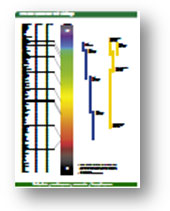Custom Oligo Labeling Services
A wide variety of fluorescent dyes can be incorporated into an oligonucleotide through these two methods:
1. Direct Oligo-Labeling During Chemical Synthesis
Direct oligo labeling using derivative dyes containing cyanoethyl phosphoramidite can be used for 5', internal and 3' labeling during chemical synthesis. The attachment of fluorescent dyes to the oligo is via the standard cyanoethyl phosphoramidite chemistry containing various spacer arm lengths. Final products are HPLC purified to remove truncated/deletion mutant products and/or oligos without the fluorescent labels.
Solid phase chemical synthesis and labeling produce higher yields and lower costs, but this method also increases the risk of the fluorescent ring to be acid-nicked, decreasing the fluorescence’s intensity. This is especially true for 3' labeling, each time a base is added during chemical synthesis. Certain fluorescent dyes are not compatible with phosphoramidite chemistry or can be degraded by the deprotection condition used in oligonucleotide production process. In this case, dye labeling must be conducted post-synthetically through various means of cross-linking chemistry.
2. Post-Synthetic Fluorescent Oligo Conjugation
Attachment of a fluorescent dye to an oligonucleotide can be achieved by using activated dyes with oligo containing functional group such as amino, thio, aldehyde, azide and carboxylic groups. The functionalized oligo is then purified by HPLC to remove truncated products, followed by the conjugation of oligo with activated dye with appropriate cross-linking chemistry. After conjugation, 2nd HPLC is used to remove uncoupled dye. This method results in lower yield since dual HPLC is required, but the dye is never exposed to acid and the rings remain intact, resulting higher fluorescent intensity.
Category of Fluorescent Probes
Several categories of fluorescent dyes and their derivatives can be conjugated in our laboratory in three standard scales: 100 nmole, 250 nmole and 1 mole.
- Fluorescein
- Rhodamine
- Coumarin
- BODIPY
- Cascade Blue
- Lucifer Yellow
- Phycobiliprotein Derivatives
- Cyanine Dye Derivative
- Chelates for Time-resolved fluorescent
- Quantum Dot
 Click image for available dyes
Click image for available dyes
Ordering and Submitting Requests for Bioconjugation Services
For us to better understand your customized project, please complete our Bioconjugation Service Questionnaire. The more our chemists understand your project’s needs, the more accurate your provided feedback will be. Providing us with your project’s details enables us to recommend the best reagents to use for your project. The most useful and readily available tools for bioconjugation projects are cross-linking reagents. A large number of cross-linkers, also known as bifunctional reagents, have been developed. There are several ways to classify the cross-linkers, such as the type of reactive group, hydrophobicity or hydrophilicity and the length of the spacer between reactive groups. Other factors to consider are whether the two reactive groups are the same or different (i.e. heterobifunctional or homobifunctional reagents), spacer is cleavable and if reagents are membrane permeable or impermeable. The most accessible and abundant reactive groups in proteins are the ϵ-amino groups of lysine. Therefore, a large number of the most common cross-linkers are amino selective reagents, such as imidoesters, sulfo-N-hydroxysuccinimide esters and N-hydroxysuccinimide esters. Due to the high reactivity of the thiol group with N-ethylmaleimide, iodoacetate and a-halocarbonyl compounds, new cross-linkers have been developed containing maleimide and a-carbonyl moieties. Usually, N-alkylmaleimides are more stable than their N-aryl counterparts.
In addition to the reactive groups on the cross-linkers, a wide variety of connectors and spacer arms have also been developed. The nature and length of the spacer arm play an important role in the functionality. Longer spacer arms are generally more effective when coupling large proteins or those with sterically protected reactive side-chains. Other important considerations are the hydrophobicity, hydrophilicity and the conformational flexibility. Long aliphatic chains generally fold on themselves when in an aqueous environment, making the actual distance spanned by such linker arms less than expected. Instead, spacers containing more rigid structures (for example, aromatic groups or cycloalkanes) should be used. These structures, however, tend to be very hydrophobic which could significantly decrease the solubility of the modified molecules or even modify some of their properties. In such cases, it is recommended to choose a spacer that contains an alkyl ether (PEO) chain. Bio-Synthesis offers several cross-linkers with PEO chains, such as thiol-binding homobifunctional reagents, heterobifunctional bases and their derivatives.
Within 3-5 days upon receiving your project scope, we will provide you an appropriate quotation. An order can be placed with PO (Purchase Order) or major credit cards (  ). Your credit card will be billed under Bio-Synthesis, Inc.
). Your credit card will be billed under Bio-Synthesis, Inc.